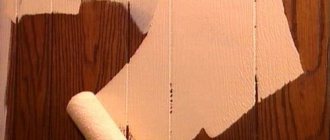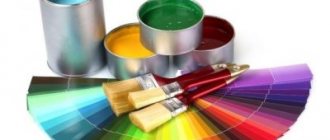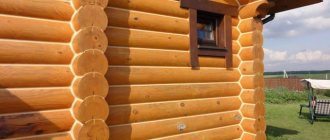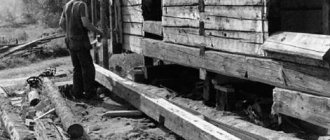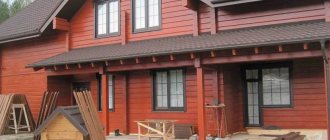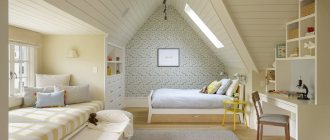Wooden lining is a beautiful, natural material. It is not surprising that so many users around the world prefer it as a finishing and facing material.
The environmental friendliness and natural beauty of wood not only decorates the room, but also creates a certain microclimate in it. And the lining covered with a thick coating (paint, varnish) allows you to create any decor.
But wood has a significant disadvantage that affects the performance characteristics of the lining - it is subject to rotting, various damage, and also tends to darken.
This article is intended for those who want to protect and at the same time preserve the lining in its natural form. Let's consider step by step how and what is the best way to coat (impregnate, treat, paint) wooden lining (euro lining).
I must say that the “take a brush, paint and paint” method is good precisely because of its simplicity. But how long will wood painted this way last? Wouldn't it be better to take a more thorough and correct approach?
Proper painting of wooden lining consists of 4 stages:
Tips for choosing a finishing coating for wooden lining
- color . Since stain or paint changes the color or shade of the lining, you need to use this property. For example, light shades visually increase the space. The use of different colors/shades allows you to zone the room;
- compound . The prefix “bio” after the name of the varnish indicates the absence of harmful substances. This composition can be used for interior work;
- manufacturer . Many domestic analogues of lining varnish or paint can create worthy competition for foreign goods. At the same time, the price of the product will be more humane.
How and with what to paint the lining in the bathhouse and steam room
Wax composition Evrotex-Sauna for lining in a bathhouse Due to the high temperature, it is better not to paint the lining in a bathhouse, but to treat it with protective compounds.
An excellent solution would be to use wax compounds, for example, Evrotex-Sauna. This coating is suitable for use in conditions of high temperature and cyclic intensive humidification.
Advice. You only need to apply the varnish once in the sauna. In the dressing room - you can make several layers.
How and with what to paint the lining on the veranda
The veranda or terrace is exposed to the greatest influence of atmospheric factors, so the material must be resistant. First coat with a layer of primer, and then 2-3 layers of varnish or paint.
How and with what to paint the lining inside/outside the house
There are no particular differences in painting a house outside or inside. The only difference is in the coatings used. Varnish/paint for interior work must meet environmentally friendly requirements. For outdoor work, it is more important that the coating can withstand moisture, temperature changes, and exposure to UV rays. The same type of paint can be used inside and outside a building. The difference is in the number of layers applied.
How to paint lining correctly - tool
To paint the lining you can use:
- brush. They are convenient because they allow you to paint wood in corners and hard-to-reach places. The paint is applied most evenly with a brush;
Advice. To apply the paint with a brush evenly and avoid smudges, you need to immerse the brush halfway in the paint.
- roller Allows you to paint quickly. However, to obtain a uniform layer you need to paint several times;
- spray. Allows you to get the job done as quickly as possible. But it increases paint consumption;
- mitten (chain-shaped). It is convenient to use a glove to paint (impregnate) the places where the lining joins (frames) the pipes;
- foam sponge.
Types of compositions
How to cover the lining inside a house is an easily resolved question, because there are many products on sale for different climatic zones and types of buildings.
Composite impregnations are designed to perform several functions, the main ones of which are the following:
- decreased flammability,
- protection against microbes,
- improvement of appearance,
- increasing mechanical strength.
There are products designed primarily to protect the lining, and compositions created for a decorative effect. Many drugs perform multiple functions equally successfully.
Wood paneling painting technology
- Before painting or applying varnish/paint, they must be mixed well. This way they will lie more evenly;
- a test paint will allow you to understand what the painted surface will look like;
- It is better to apply the paint in several thin layers. This way, each layer will dry faster and the coating will be applied more evenly;
- the next layer of paint/varnish should be applied only after the first one has completely dried;
- When painting the lining, you need to leave gaps of 2-3 cm at the top and bottom of the panels. This will allow the tree to breathe. And the gaps themselves can be closed with decorative plinths;
- to avoid obtaining different shades of wood, it is better to paint with paint at a time, using material from one batch;
- if there is a need to interrupt work, try to make sure that the “seam”, the border of the painted and unpainted area, is not in a visible place;
Tips for storing an open can of paint:
If work is interrupted for a long time, then in order to prevent a film from appearing on the surface of the paint, you can put cardboard impregnated with drying oil on the surface.
If a film appears, its particles may fall on the surface to be painted. In this case, it is better to cover the surface with foam rubber and dip the brush through it.
- a more saturated color/shade can be obtained if you apply the paint several times (up to 4). Further increasing the number of layers will have no effect;
- Do not allow paint/varnish to dry too quickly. This may cause the painted layer to crack. Professionals do not recommend applying paint/varnish in direct sunlight.
Paints
This type of product differs from the ones described above in that an opaque film is created on the surface. Therefore, if you need to get a specific color, then this option is perfect.
Paint allows you to give the lining any color
There are also many composition options; before covering the lining in the house, you need to choose a specific solution:
- Oil paints are a traditional option that is being used less and less these days. The composition has good protective properties, but it is short-lived; after a year or two, the coating needs to be renewed. Another disadvantage is the small selection of colors;
Oil paints are rarely used
- Alkyd paints are very popular because they adhere very well to the surface and do not lift the fibers of the material. The composition is distributed in a thin layer and forms a durable film that protects well from moisture and has good wear resistance;
This option has a much wider choice of colors.
- Acrylic compositions make it possible to create an attractive and durable coating for eurolining. They are absolutely harmless, which allows them to be used in premises for any purpose. The paints are water-based and come in a huge variety of shades. You can simply buy white composition and pigments and create your own unique color.
Acrylic compositions retain the brightness of colors for a very long time
How to cover the lining outside and inside the house
Wooden lining is a beautiful, natural material Wooden lining is a beautiful, natural material. It is not surprising that so many users around the world prefer it as a finishing and facing material.
The environmental friendliness and natural beauty of wood not only decorates the room, but also creates a certain microclimate in it. And the lining covered with a thick coating (paint, varnish) allows you to create any decor.
But wood has a significant disadvantage that affects the performance characteristics of the lining - it is subject to rotting, various damage, and also tends to darken.
Oil-wax
Impregnations using a composition made on the basis of oil and wax ingredients, in contrast to paint and varnish coatings, have a number of positive advantages:
- The ability not to spoil, but to preserve the natural texture of wood .
- High resistance to temperature changes.
The use of such compositions is permissible in rooms with high humidity. The impregnating material is deeply absorbed into the surface and contributes to reliable protection of the product.
- The vapor permeability of the surface is ensured by this composition, and allows the treated surface to “breathe”.
If a defect is found in any part of the wooden surface, it can be impregnated with a composition of oil and wax, without having to do the same procedure with all surfaces of the wall. It is enough to apply a layer only to the damaged area .
In order to choose a high-quality composition for work, you need to pay attention to the components of the material, which must contain natural oils , such as linseed, tallow or teak.
In addition to oils, the composition must contain a safe, odorless solvent that does not use benzene . In addition to solvent and natural oil, the manufacturer fills the mixture with wax and pigments.
Manufacturers of impregnations
There are popular brands that produce high-quality lining compounds. The selection of products is made easier when the list is narrowed down to impregnations that are in demand and tested by customers:
- Finncolor, available in glossy and matte, belongs to acrylate products, you can add dye to give the desired shade;
- The composite does not emit an unpleasant odor and does not change the shade of the base, and dries quickly;
- Commander, an eco-friendly type that is also suitable for children's rooms;
- Eurotex is a good option if you need to carry out treatment in a room where there is high humidity;
- Belinka, creates a matte finish;
- Pinotex "Interior" creates colorless protection and is odorless.
A good option if you need to carry out treatment in a room where there is high humidity.
Impregnating the lining will serve to strengthen the material, create a barrier against various harmful factors, and also make the base more aesthetically beautiful. Internal processing requires options that are safe for human health. When choosing, take into account the operating conditions and requirements for the appearance of the coating.
Painting works and tools for them
Some have not encountered this type of work, so it will be useful for them to learn all the technical aspects of finishing with lining and painting it.
So, what tools will you need to carry out painting work:
- paint roller;
- paint brushes, the bristles of which should be hard. There should be several of them;
- construction tape;
- sandpaper (grit number 240);
- napkins;
- container for roller and brushes.
Painting tools
We advise you to rinse your brushes in a soapy solution before starting work, so that during the process they do not leave their fluff on the surface to be painted and treated.
Treatment with protective compounds
The quality of your work will depend on attentiveness and accuracy, as well as on the correctness and consistency of compliance with all rules and recommendations. Full instructions are presented in the video:
Colored wax for wood
Oil wax for wood is not a metaphor, but an oil-wax composition!
- oil and wax for wood (bees), 1 liter per 12 -15 sq.m.
- oil with hard wax for wood (carnauba), 1 liter from 20 sq.m.
- All products come with ready-made factory tinting
- our coatings never peel off
- are not afraid of moisture and temperature changes
- 100% organic without added chemicals
- Application demonstration before purchase
- delivery to regions
- discounts
Why is impregnation needed?
Impregnation for lining does not seem to everyone to be a mandatory step on a balcony, bathhouse, house or other structure when it was used from the inside. However, if the boards are not processed, then after a short time defects will appear on their basis.
If the ventilation in the room is poor, then a blue discoloration will form on the surface; if the coating is constantly exposed to ultraviolet radiation, the color will turn into a dark gray shade.
The blue stain is acquired from microorganisms and can be removed using chlorine, which leaves a white coating, but the process is not easy and the product emits a strong odor. The grayishness can be removed by sanding the base, but reappearance is inevitable.
By impregnating the base, you can give the lining a more pleasant design; if moisture-resistant products are used, the material will last a long time even in a room that is not heated, when the dampness is high.
If the boards are not processed, then after a short time defects will appear on their basis.

